The C7 guitar chord, also known as C dominant 7th, is a versatile and commonly used chord that adds tension and color to your music. It’s used in various genres like blues, jazz, rock, and pop, and is often played to create a sense of movement towards a resolution. In this guide, we’ll cover how to play the C7 chord, its variations, common mistakes, and much more.
What is a C7 Guitar Chord?
The C7 chord is a dominant 7th chord built from the C major chord. It consists of four notes: C, E, G, and B♭. The extra note, B♭, creates a tension that makes the chord sound more complex and unresolved compared to a regular major chord. This tension often leads to a resolution, usually to the F major chord, which makes C7 a vital chord in many musical progressions.
C7 Formula:
- Root (C)
- Major third (E)
- Perfect fifth (G)
- Minor seventh (B♭)
How to Play the C7 Guitar Chord
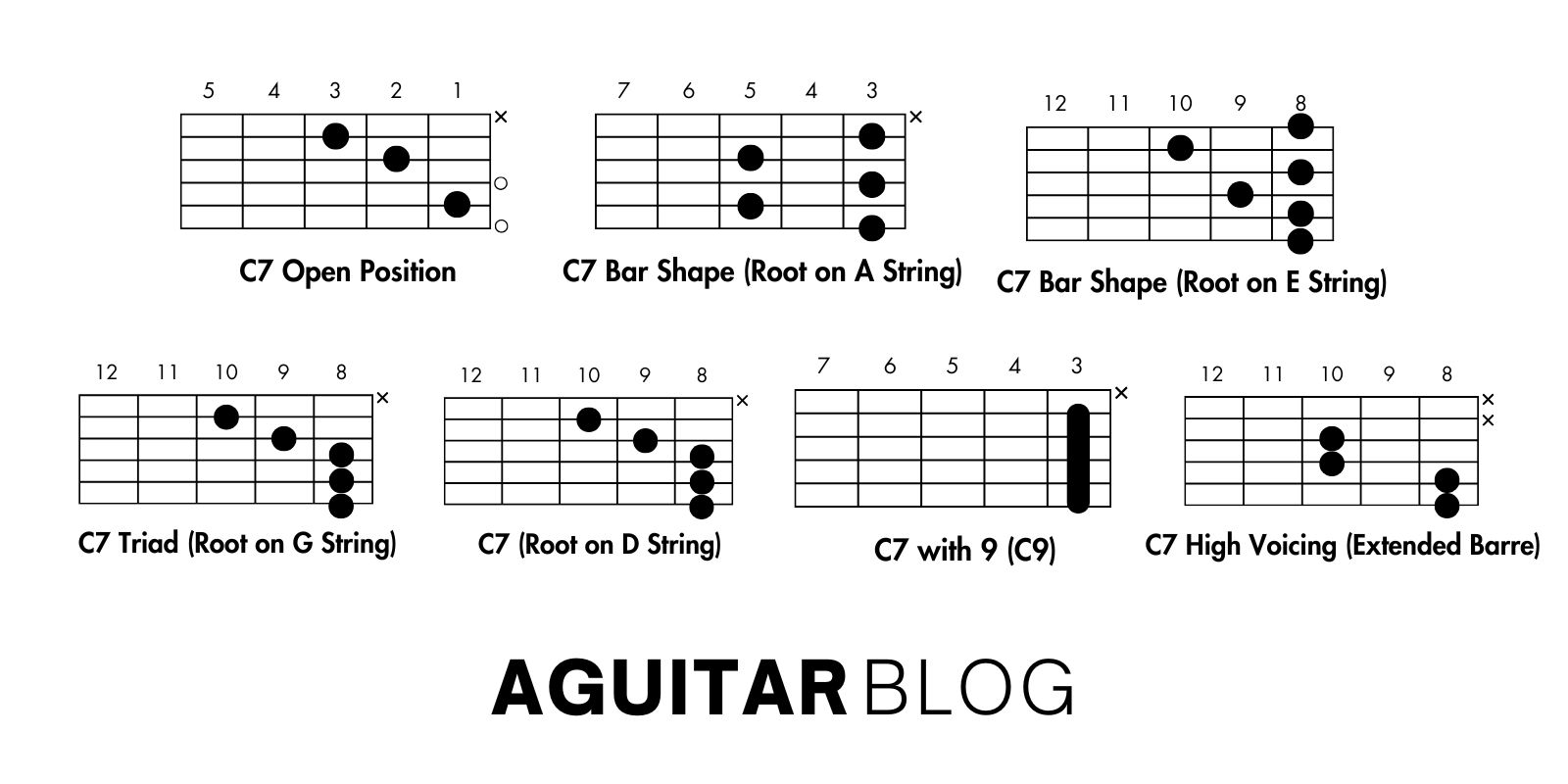
The C7 chord is a crucial part of many styles of music, offering a distinct, bluesy sound. In this guide, we’ll explore different C7 chord variations, showing you how to play each one and how they impact the tone. Whether you’re a beginner or advanced player, mastering these variations will enhance your guitar skills.
C7 Open Position
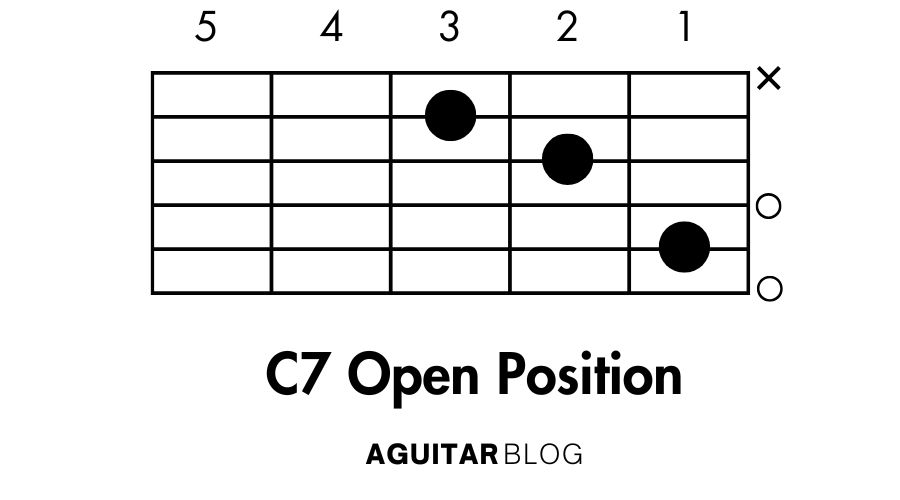
The C7 open position chord has a bright, full sound, thanks to the open strings. It is commonly used in blues, folk, and early rock styles. The dominant seventh gives it a sense of tension, which naturally leads to a resolution in many chord progressions. The open voicing also contributes to a relaxed, warm feel.
How to Play:
- Low E String: Mute this string (don’t play it).
- A String: Place your ring finger on the 3rd fret of the A string.
- D String: Place your middle finger on the 2nd fret of the D string.
- G String: Let the G string ring open.
- B String: Press your index finger on the 1st fret of the B string.
- High E String: Let the high E string ring open.
C7 Bar Shape (Root on A String)
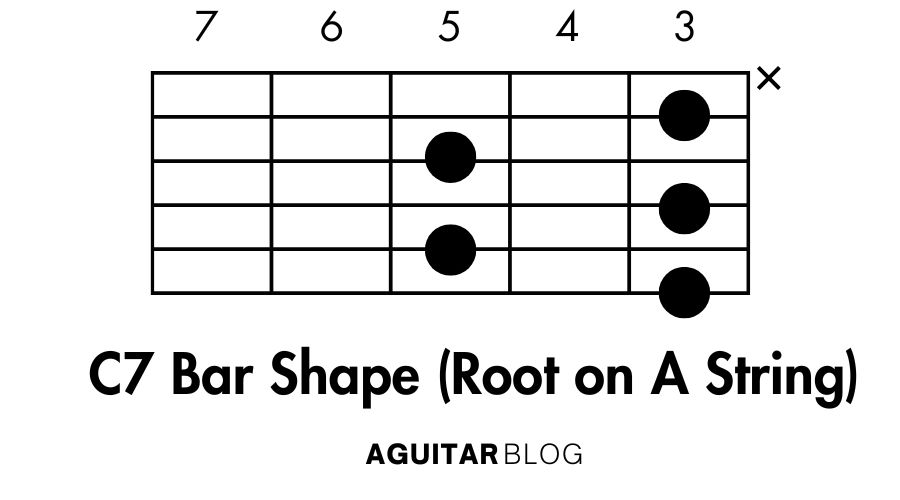
This C7 bar shape (root on the A string) produces a punchy, clear sound with a focused bass. The strong bar ensures clean, sharp notes, and the voicing sits nicely within the chord progression, making it perfect for rhythm guitar and blues-based music.
How to Play:
- Mute the Low E String (don’t play it).
- Press your index finger on the 3rd fret of the A string.
- Press your ring finger on the 5th fret of the D string.
- Press your pinky on the 5th fret of the G string.
- Press your middle finger on the 5th fret of the B string.
- Let the high E string ring open.
C7 Bar Shape (Root on E String)
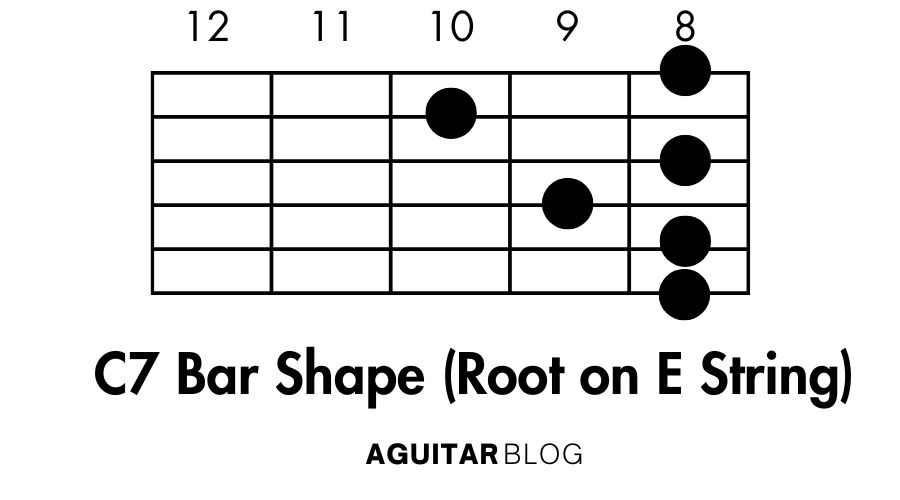
This C7 bar shape rooted on the low E string offers a bold, aggressive sound. It’s great for rhythm and lead parts that need to stand out. The sharpness of the voicing makes it perfect for genres like rock, jazz, and blues.
How to Play:
- Place your index finger on the 8th fret of the Low E string.
- Place your middle finger on the 10th fret of the A string.
- Place your index finger on the 8th fret of the D string.
- Place your ring finger on the 9th fret of the G string.
- Place your index finger on the 8th fret of the B string.
- Place your index finger on the 8th fret of the high E string.
C7 Triad (Root on G String)
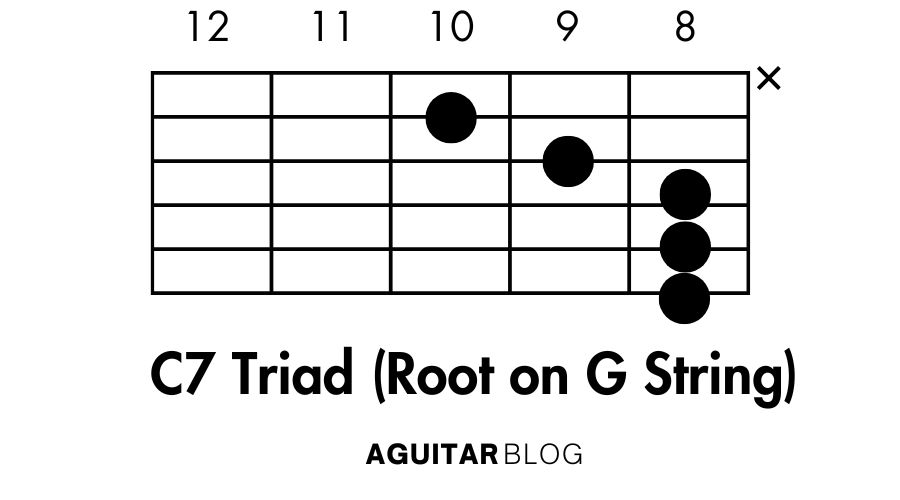
This triad version of the C7 chord gives a brighter and more compact sound. It’s great for melodic playing or when you want a smooth, minimalistic feel without needing to play a full bar chord.
How to Play:
- Mute the Low E, A, and D Strings (don’t play them).
- Place your index finger on the 10th fret of the G string.
- Place your ring finger on the 9th fret of the B string.
- Place your index finger on the 8th fret of the high E string.
C7 (Root on D String)
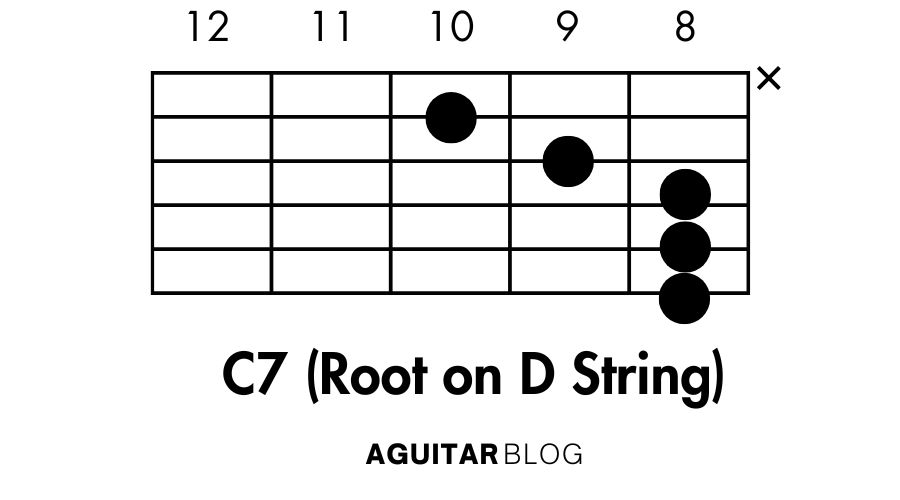
This variation emphasizes the higher-pitched notes and provides a more delicate, jazzy sound. It’s perfect for playing in the higher registers, whether you’re soloing or adding more harmonic texture to a progression.
How to Play:
- Mute the Low E, A, and G Strings (don’t play them).
- Place your index finger on the 10th fret of the D string.
- Place your ring finger on the 9th fret of the G string.
- Place your index finger on the 8th fret of the B string.
- Place your index finger on the 8th fret of the high E string.
C7 with 9 (C9)
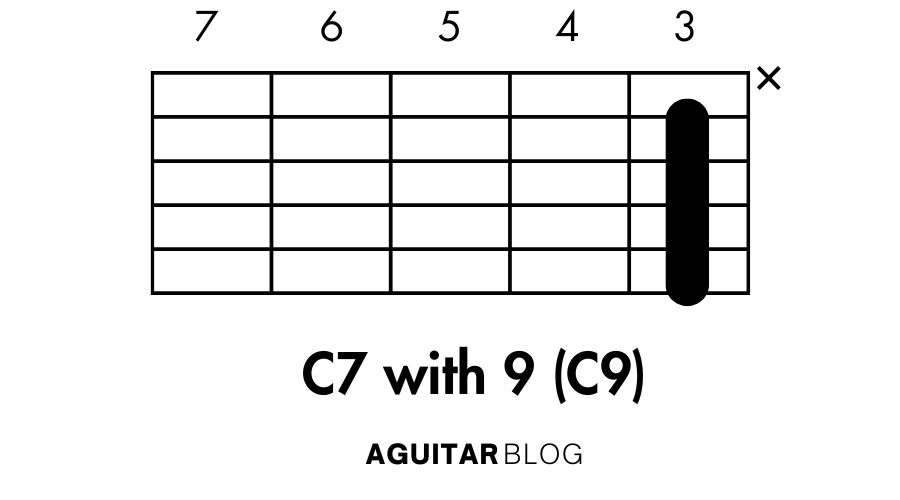
The C9 variation adds an extra dissonant flavor, providing a more colorful and jazzy sound. The addition of the 9th (D) adds harmonic complexity, making it ideal for jazz, funk, and blues progressions that require a bit more color.
How to Play:
- Mute the Low E String (don’t play it).
- Place your index finger on the 3rd fret of the A string.
- Place your index finger on the 3rd fret of the D string.
- Place your index finger on the 3rd fret of the G string.
- Place your index finger on the 3rd fret of the B string.
- Place your index finger on the 3rd fret of the high E string.
C7 High Voicing (Extended Barre)
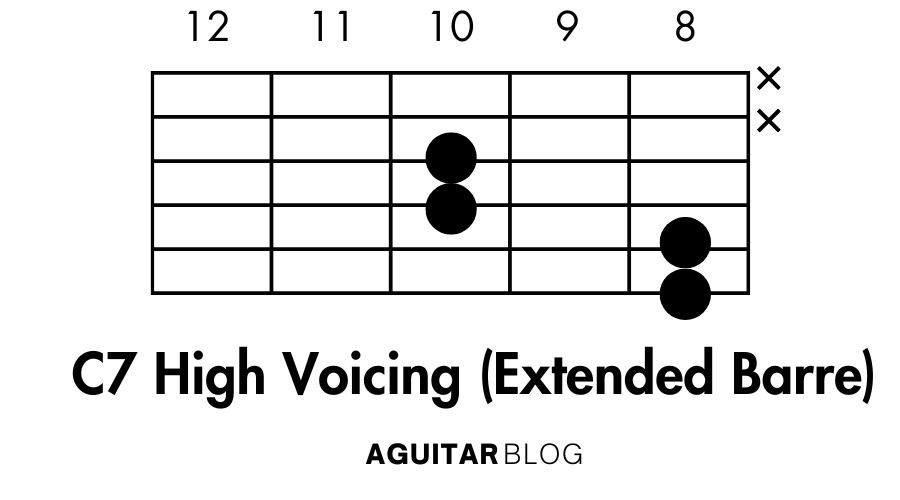
This C7 high voicing has an ethereal, shimmering tone, perfect for atmospheric or layered arrangements. The voicing is delicate and expressive, making it ideal for studio work or compositions where the harmonic texture is as important as the melody.
How to Play:
- Mute the Low E and A Strings (don’t play them).
- Place your index finger across the 8th fret of the B and high E strings.
- Place your middle finger on the 10th fret of the D string.
- Place your ring finger on the 10th fret of the G string.
- Strum only the D, G, B, and high E strings for a bright, resonant sound.
These C7 chord variations each offer unique tones and textures, making them suitable for a variety of musical styles, from classic blues to modern jazz and rock. Whether you prefer open, bar, or triadic shapes, each one provides a distinct feel and helps create a different vibe in your playing.
Top 5 Songs Featuring the C7 Guitar Chord
The C7 chord is a key element in many music genres, adding tension and emotion to songs. In this article, we’ll explore 5 iconic songs that feature the C7 chord, showing how it enhances blues, jazz, rock, and pop. From “Sweet Home Chicago” to “Rude,” discover how the C7 chord shapes each track’s unique sound.
“Hound Dog” by Elvis Presley
- Key: C Major
- Chord Progression: C7 – C7 – C7 – C7 (Throughout the song)
Why the C7 Chord is Essential:
“Hound Dog” is an iconic rock ‘n’ roll song that uses the C7 chord as the central driving force throughout. The C7 creates a bluesy feel and adds tension to the progression. The repetitive nature of the chord in this song allows the C7 to stand out as the foundation of the song, creating a catchy, rebellious energy.
How the C7 Works:
The song sticks to a straightforward 12-bar blues progression in the key of C, and the C7 chord is played throughout the song as the dominant chord. It gives the song its bluesy flavor, making it ideal for beginners to practice rhythm and playing the C7 chord consistently.
How to Play:
Play the C7 chord in the open position (X32010) for an authentic, bright rock sound. Strum the C7 with a quick rhythm to match the upbeat tempo of the song.
“Sweet Home Chicago” by Robert Johnson
- Key: E Major (with C7 used in the progression)
- Chord Progression: C7 – F7 – C7 – G7 – F7 – C7
Why the C7 Chord is Essential:
“Sweet Home Chicago” is a classic blues standard that relies heavily on dominant seventh chords, with C7 playing a central role in the progression. This progression is a typical 12-bar blues, with the C7 serving as both the tonic and dominant chord, creating tension that resolves back to the tonic.
How the C7 Works:
The C7 is used in the second bar as the IV chord, moving from the I (E7) to the IV (A7), then resolving back to I. The C7 introduces a shift in the tonality and adds richness to the harmonic movement, providing a solid foundation for the call-and-response blues phrasing.
How to Play:
For C7, you can play the X35353 voicing, giving a fuller, deeper tone that suits the blues feel. Incorporate a shuffle rhythm for the strumming pattern and add some subtle bends and slides in your lead to bring out the soulful character of the piece.
“Twinkle, Twinkle Little Star” (Jazz Version)
- Key: C Major
- Chord Progression: C7 – G7 – C7
Why the C7 Chord is Essential:
In jazz interpretations of “Twinkle, Twinkle Little Star”, the C7 chord replaces the traditional major chord, adding a sophisticated and jazzy twist to a simple melody. This jazz version incorporates dominant seventh chords to provide a more complex harmonic structure.
How the C7 Works:
The C7 chord adds a touch of tension and sets the stage for a smoother resolution back to the tonic chord (C major). In jazz, dominant seventh chords like the C7 are often used to add harmonic richness and anticipation before resolving to the tonic chord.
How to Play:
For this version, you can use the X32010 open voicing of C7 for a smooth, bright sound. Experiment with fingerpicking for a more intricate, jazzy feel, and use the G7 (320001) to resolve back to the tonic C7.
“The Thrill Is Gone” by B.B. King
- Key: B Minor (with C7 used in the progression)
- Chord Progression: C7 – F7 – C7 – G7
Why the C7 Chord is Essential:
This soulful blues tune features C7 as part of a classic 12-bar blues progression. C7 creates a sense of emotional depth and longing, perfect for B.B. King’s expressive guitar work and lyrical phrasing. The C7 brings the bluesy feel to the fore and provides the necessary tension before resolving back to the tonic chord.
How the C7 Works:
In “The Thrill Is Gone,” the C7 acts as a dominant chord, giving the progression a sense of movement and unresolved tension that resolves back to the tonic. The chord is used both as part of the turnaround and as a point of harmonic contrast in the progression.
How to Play:
Use the X35353 voicing for a deeper, more defined sound. Play the chord with a slow, bluesy shuffle rhythm, emphasizing the emotional, expressive bends in the lead guitar. This song is perfect for practicing C7 in a laid-back, soulful context.
“Rude” by MAGIC!
- Key: C Major
- Chord Progression: C7 – F7 – C7 – G7
Why the C7 Chord is Essential:
“Rude” blends reggae and pop styles, and the C7 chord is used in the progression to give the song its fun, laid-back, yet somewhat funky vibe. The C7 provides the harmonic drive in this catchy, upbeat tune, giving it a jazzy and playful feel.
How the C7 Works:
The C7 functions as a dominant chord, creating tension that resolves to the next chord. Its bluesy character enhances the rhythmic, offbeat feel of the reggae groove while contributing to the pop sensibilities of the song.
How to Play:
Play the C7 chord in the open position (X32010) for a bright and punchy tone. Strum with a light, reggae-style rhythm, emphasizing the offbeats. The use of syncopation and subtle muted strums can enhance the groove.
Summary of Songs Featuring the C7 Chord:
- “Hound Dog” by Elvis Presley – A rock ‘n’ roll classic, where C7 creates a bluesy, rebellious sound.
- “Sweet Home Chicago” by Robert Johnson – A 12-bar blues progression featuring C7 as the dominant chord.
- “Twinkle, Twinkle Little Star” (Jazz Version) – A jazz interpretation of a children’s song using C7 to add harmonic sophistication.
- “The Thrill Is Gone” by B.B. King – A soulful blues ballad where C7 adds emotional depth and tension.
- “Rude” by MAGIC! – A reggae-pop hit using C7 for a playful, jazzy twist.
These songs showcase the C7 chord in a variety of styles and give you opportunities to explore its harmonic function in different contexts. Whether you’re playing blues, jazz, pop, or rock, the C7 chord is an essential tool for any guitarist looking to add color and depth to their playing.
Mastering the C7 guitar chord and its variations opens up a world of musical possibilities, whether you’re playing blues, jazz, rock, or pop. By experimenting with different voicings, you can bring a unique flavor to your playing. We hope this guide has helped you better understand the C7 chord and its role in music. For more guitar tips, lessons, and chord guides, be sure to visit AGuitar Blog—your go-to resource for everything guitar-related. Keep practicing, and happy playing!
SEE ALSO RELATED C CHORDS